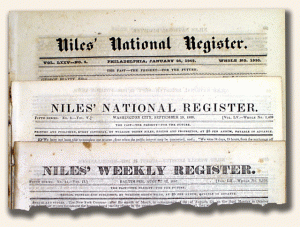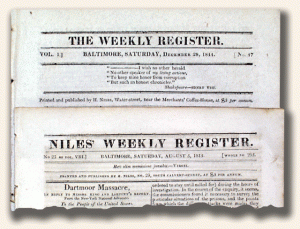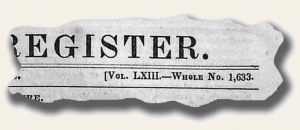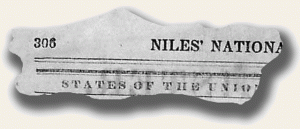“New Series” of a newspaper…
September 7, 2009 by TimHughes · Leave a Comment
 A recent inquiry by a concerned customer about the words “fifth series” printed in the dateline of his “Niles’ National Register” prompted me to share my comments with our blog readers should you have similar concerns of such notes atop this and other titles held in your collection.
A recent inquiry by a concerned customer about the words “fifth series” printed in the dateline of his “Niles’ National Register” prompted me to share my comments with our blog readers should you have similar concerns of such notes atop this and other titles held in your collection.
Through the life of any newspaper which lasted beyond ten years it would not be uncommon for the title to change, either slightly or dramatically. This could happen for a number of reasons, such as the merging with another newspaper, the purchase of the paper by a new publisher, new city of publication, an altering in the size, theme, or format of the newspaper, etc. While some titles made no note of such changes in their volume and issue numbering, some chose to create a “new series” and start anew with the volume & issue numbering.
 “The Weekly Register“, which began in Baltimore, chose the latter. The photos show five of the title or location changes in a 38 year time spread, not to mention size and type font changes as well. Note that its location moved from Baltimore to “Washington City” to Philadelphia.
“The Weekly Register“, which began in Baltimore, chose the latter. The photos show five of the title or location changes in a 38 year time spread, not to mention size and type font changes as well. Note that its location moved from Baltimore to “Washington City” to Philadelphia.
Fortunately Niles chose to also retain the original volume numbering as well (right side of the dateline) as well as the “whole number”, or the number since the very first issue was published. Other titles did not choose to do so, making it more difficult to determine the newspaper’s age.
Numbering an issue….how was it done?
April 6, 2009 by TimHughes · Leave a Comment
 The numbers noted at the top of the front page of a newspaper, typically at the far left and right of the dateline, may seem a bit confusing so I’ll try to explain what they mean.
The numbers noted at the top of the front page of a newspaper, typically at the far left and right of the dateline, may seem a bit confusing so I’ll try to explain what they mean.
Most newspapers had two sets of numbers: 1) the issue & volume numbers, and 2) the whole number.
The issue & volume number often appear such as “Vol. 5 num. 237” which means this is the 237th issue from the fifth year of the newspapers existence. Newspapers would assign a volume number to their publication which would increase by one on the anniversary of its beginning, so if a newspapers published it’s first issue on March 5, 1837, volume two would begin with the first publication after March 5, 1838. The issue number notes the issue from within that volume, meaning that issue “Vol. 5 num. 313” might be followed by issue “Vol. 6 num. 1” if the newspaper published 6 days a week (365 days less 52 Sundays = 313 published issues in the year).
 But to many the more mysterious number is the “whole number”. Essentially it indicates how many issues have been published since the founding of the paper, and can be a very large number if the paper has been in publication for many years.
But to many the more mysterious number is the “whole number”. Essentially it indicates how many issues have been published since the founding of the paper, and can be a very large number if the paper has been in publication for many years.
Using the above example of “vol. 5 num. 313” the “whole number” of this issue would likely be 1565 (313 issues per year x 5 years = 1565). And the very next issue, noted as “vol. 6 num 1” would be whole number 1566.
 The tricky thing is that when some newspapers were sold, reorganized, changed their name, or merged with another they might begin a “new series” and the volume/issue numbers would begin afresh, and the whole number may or may not start over with number 1, depending on the whim of the publisher. So these numbers cannot be depended upon to give an accurate reflection of how old the newspaper is, nor the number of issues that were printed since its inception. Niles’ National Register did this at least twice in its 40 years’ existence.
The tricky thing is that when some newspapers were sold, reorganized, changed their name, or merged with another they might begin a “new series” and the volume/issue numbers would begin afresh, and the whole number may or may not start over with number 1, depending on the whim of the publisher. So these numbers cannot be depended upon to give an accurate reflection of how old the newspaper is, nor the number of issues that were printed since its inception. Niles’ National Register did this at least twice in its 40 years’ existence.




